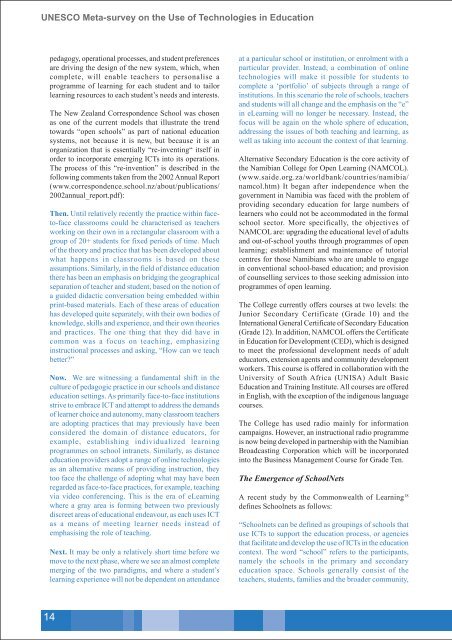Download (PDF, 2.MB) - UNESCO Bangkok
Download (PDF, 2.MB) - UNESCO Bangkok
Download (PDF, 2.MB) - UNESCO Bangkok
- No tags were found...
Create successful ePaper yourself
Turn your PDF publications into a flip-book with our unique Google optimized e-Paper software.
<strong>UNESCO</strong> Meta-survey on the Use of Technologies in Educationpedagogy, operational processes, and student preferencesare driving the design of the new system, which, whencomplete, will enable teachers to personalise aprogramme of learning for each student and to tailorlearning resources to each student’s needs and interests.The New Zealand Correspondence School was chosenas one of the current models that illustrate the trendtowards “open schools” as part of national educationsystems, not because it is new, but because it is anorganization that is essentially “re-inventing“ itself inorder to incorporate emerging ICTs into its operations.The process of this “re-invention” is described in thefollowing comments taken from the 2002 Annual Report(www.correspondence.school.nz/about/publications/2002annual_report.pdf):Then. Until relatively recently the practice within faceto-faceclassrooms could be characterised as teachersworking on their own in a rectangular classroom with agroup of 20+ students for fixed periods of time. Muchof the theory and practice that has been developed aboutwhat happens in classrooms is based on theseassumptions. Similarly, in the field of distance educationthere has been an emphasis on bridging the geographicalseparation of teacher and student, based on the notion ofa guided didactic conversation being embedded withinprint-based materials. Each of these areas of educationhas developed quite separately, with their own bodies ofknowledge, skills and experience, and their own theoriesand practices. The one thing that they did have incommon was a focus on teaching, emphasizinginstructional processes and asking, “How can we teachbetter?”Now. We are witnessing a fundamental shift in theculture of pedagogic practice in our schools and distanceeducation settings. As primarily face-to-face institutionsstrive to embrace ICT and attempt to address the demandsof learner choice and autonomy, many classroom teachersare adopting practices that may previously have beenconsidered the domain of distance educators, forexample, establishing individualized learningprogrammes on school intranets. Similarly, as distanceeducation providers adopt a range of online technologiesas an alternative means of providing instruction, theytoo face the challenge of adopting what may have beenregarded as face-to-face practices, for example, teachingvia video conferencing. This is the era of eLearningwhere a gray area is forming between two previouslydiscreet areas of educational endeavour, as each uses ICTas a means of meeting learner needs instead ofemphasising the role of teaching.Next. It may be only a relatively short time before wemove to the next phase, where we see an almost completemerging of the two paradigms, and where a student’slearning experience will not be dependent on attendanceat a particular school or institution, or enrolment with aparticular provider. Instead, a combination of onlinetechnologies will make it possible for students tocomplete a ‘portfolio’ of subjects through a range ofinstitutions. In this scenario the role of schools, teachersand students will all change and the emphasis on the “e”in eLearning will no longer be necessary. Instead, thefocus will be again on the whole sphere of education,addressing the issues of both teaching and learning, aswell as taking into account the context of that learning.Alternative Secondary Education is the core activity ofthe Namibian College for Open Learning (NAMCOL).(www.saide.org.za/worldbank/countries/namibia/namcol.htm) It began after independence when thegovernment in Namibia was faced with the problem ofproviding secondary education for large numbers oflearners who could not be accommodated in the formalschool sector. More specifically, the objectives ofNAMCOL are: upgrading the educational level of adultsand out-of-school youths through programmes of openlearning; establishment and maintenance of tutorialcentres for those Namibians who are unable to engagein conventional school-based education; and provisionof counselling services to those seeking admission intoprogrammes of open learning.The College currently offers courses at two levels: theJunior Secondary Certificate (Grade 10) and theInternational General Certificate of Secondary Education(Grade 12). In addition, NAMCOL offers the Certificatein Education for Development (CED), which is designedto meet the professional development needs of adulteducators, extension agents and community developmentworkers. This course is offered in collaboration with theUniversity of South Africa (UNISA) Adult BasicEducation and Training Institute. All courses are offeredin English, with the exception of the indigenous languagecourses.The College has used radio mainly for informationcampaigns. However, an instructional radio programmeis now being developed in partnership with the NamibianBroadcasting Corporation which will be incorporatedinto the Business Management Course for Grade Ten.The Emergence of SchoolNetsA recent study by the Commonwealth of Learning 18defines Schoolnets as follows:“Schoolnets can be defined as groupings of schools thatuse ICTs to support the education process, or agenciesthat facilitate and develop the use of ICTs in the educationcontext. The word “school” refers to the participants,namely the schools in the primary and secondaryeducation space. Schools generally consist of theteachers, students, families and the broader community,14
















